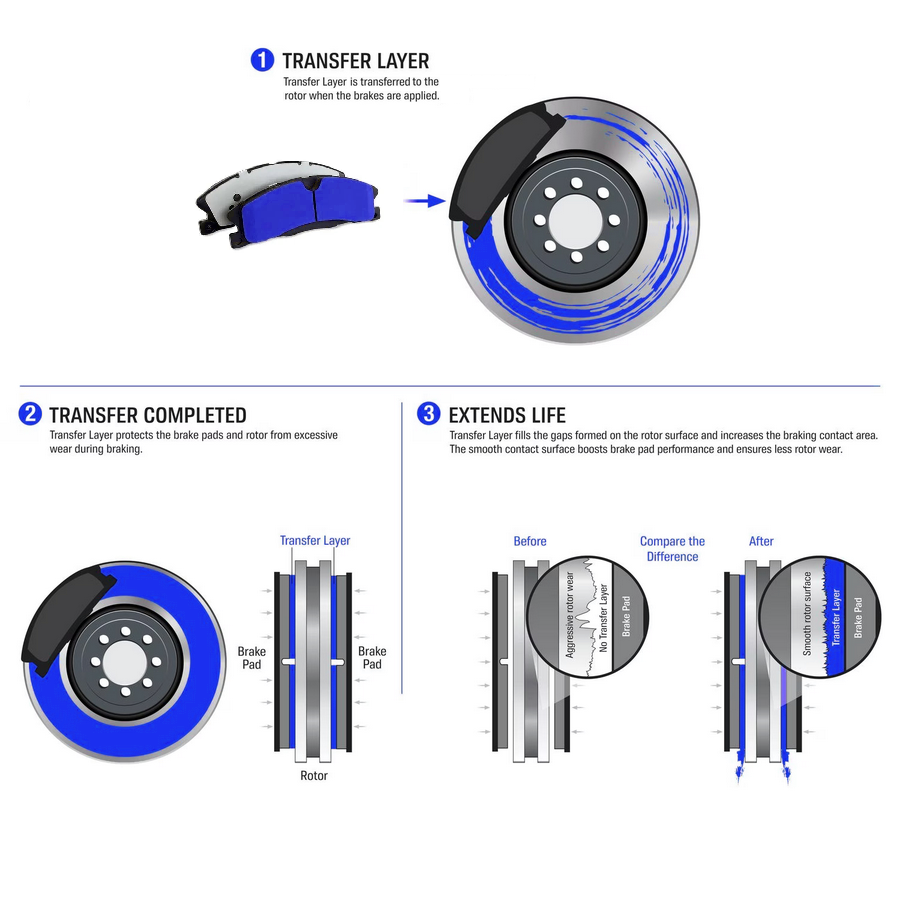Pad Break/Bed-In Procedure
Our standard break-in or bed-in procedures are outlined below, and should be followed in accordance with the application-specific brake pad break-in instructions provided by the brake pad and vehicle manufacturer.
VITAL POINTS TO NOTE DURING THE BREAK/BED-IN PROCESS FOR ALL BRAKE PADS
- Review the required procedure and locate a suitable, safe, and legal area to execute the required stops.
- Prior to initiating the break-in procedure, engage in gentle braking. Refrain from applying brakes aggressively until the break-in procedure is fully completed.
- Avoid using heavily worn or damaged rotors in conjunction with new brake pads.
- Refrain from dragging the brakes while the car is in motion during the break-in procedure.
- Do not engage the pedal while the car is stationary at any point after completing the break-in process.
- After finishing the procedure, ensure the brake system cools down entirely before entering into a race.
- Before attempting to reach race speeds, apply the pedal a few times to allow the brake pads to heat up.
- For used rotors, clean the surface with fine sandpaper or steel wool, rinse with water, dry, and install before bedding in new pads.
- In some racing scenarios, time constraints may limit the complete break-in procedure. However, it remains crucial to attempt the core elements: gradually building up heat and allowing the system to cool down entirely before racing, if feasible.
Street Brake Pad Break/Bed-In:
- Gradually introduce your new components by making 6 to 10 stops from approximately 50 to 55 KM/H applying moderate pressure.
- Follow up with 2 to 3 robust stops from approximately 65 to 75 KM/H.
- Emphasize: Avoid dragging the brakes or come to a complete stop before completing the break/bed-in procedure.
- Give your brake system a breather and wait for atleast 15 minutes to cool down.
- With these steps completed, your brakes are primed for regular use, and you can drive as you normally would.
Sport/Race Brake Pad Break/Bed-In:
- Reach a moderate speed, then gently apply the brake pedal to decelerate without a full stop. Swiftly release the pedal, avoiding brake dragging. Repeat this process four or five times.
- Increase your speed and employ the brake pedal to slow the car without a complete stop. Swiftly release the pedal, ensuring no brake dragging. Repeat this sequence five times.
- Push the brake pedal at or near race speed to slow the car without a full stop. Rapidly release the pedal without dragging the brakes. Repeat this action three times, allowing a few seconds between each engagement while the car is in motion.
- Avoid holding the brake pedal. Park the car for around 20 minutes or until the brake rotors are cool to the touch.
- If, during the previous steps, the brake pedal feels soft or brake fade is observed, promptly park the car for approximately 20 minutes without holding the brake pedal.

STOPTECH RECOMMENDS THE FOLLOWING BREAK-IN PROCEDURE
FOR APPLICATIONS SUCH AS HEAVY ROAD OR TRACK USE:
STOPTECH DOES NOT ENDORSE SPEEDING ON PUBLIC ROADS
1. Read through the procedure and find a suitable, safe and legal area to perform the necessary stops.
2. BEFORE starting the break-in procedure, drive with gentle braking. Do not use brakes aggressively until completing the break-in procedure.
3. Make a series of 15 stops from 50 to 5-10 MPH. At the end of each stop, immediately accelerate to 50 again for the next stop. Run all stops continuously in one cycle. (For Track use you can replace the recommended stops with 10 stops from 60 to 5-10).
4. During the 50 (60) to 5-10 MPH series of stops, the exact speed is not critical. Accelerate to approximately 50 (60) and begin the braking cycle.
KEEP YOUR EYES ON THE ROAD AND APPROXIMATE YOUR SPEED AT THE END OF EACH CYCLE.
5. A moderate braking effort is needed to properly bed-in the rotors and pads. A stopping force of approximately 0.8G’s, or just short of ABS intervention is the level of pedal effort you are trying to attain.
NOTE: BEFORE COMPLETING THE BREAK-IN, DO NOT COME TO A COMPLETE STOP WHILE THE PADS AND ROTORS ARE VERY HOT! THIS WILL TRANSFER PAD MATERIAL NON-UNIFORMLY ONTO THE ROTOR, CAUSING A VIBRATION DURING FUTURE USE.
If the break-in cannot be done or is deemed hazardous under the circumstances, then taking the opportunity to brake hard but not to the point of high temperatures being realized prior to break-in being completed, can eventually yield the same result. Estimated miles to accomplish this will vary with actual use but can be as much as or more than 600 miles.


Login and Registration Form